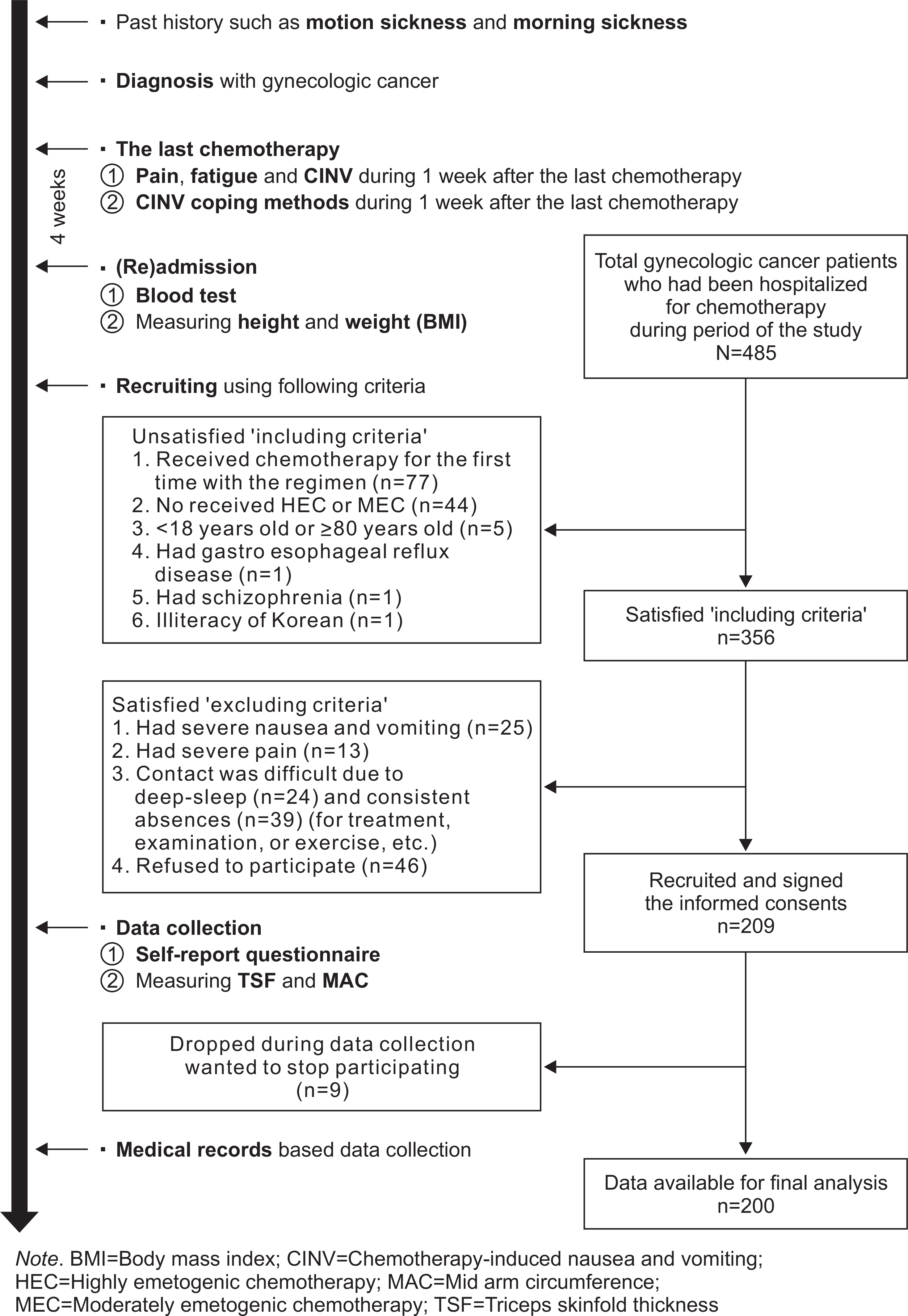1. Flaherty AM. Historical perspective on the progress of chemotherapy-induced nausea and vomiting treatment in oncology nursing forum. Oncology Nursing Forum. 2013; 40(3):205–207. https://doi.org/10.1188/13.ONF.205-207.
2. Haiderali A, Menditto L, Good M, Teitelbaum A, Wegner J. Impact on daily functioning and indirect/direct costs associated with chemotherapy-induced nausea and vomiting (CINV) in a U.S. population. Supportive Care in Cancer. 2011; 19(6):843–851. https://doi.org/10.1007/s00520-010-0915-9.

3. Nho JH, Kim SR, Kang GS, Kwon YS. Relationships among malnutrition, depression and quality of life in patients with gynecologic cancer receiving chemotherapy. Korean Journal of Women Health Nursing. 2014; 20(2):117–125. https://doi.org/10.4069/kjwhn.2014.20.2.117.

4. Park EH, Kim HJ. Nutritional status and fatigue in women cancer patients receiving chemotherapy. Journal of Korean Academy of Fundamentals of Nursing. 2015; 22(4):387–397. https://doi.org/10.7739/jkafn.2015.22.4.387.

5. Davidson W, Teleni L, Muller J, Ferguson M, McCarthy AL, Vick J, et al. Malnutrition and chemotherapy-induced nausea and vomiting: Implications for practice. Oncology Nursing Forum. 2012; 39(4):E340–E345. https://doi.org/10.1188/12.ONF.E340-E345.

6. Kim YJ, Kim JY, Choi IR, Kim MW, Rhodes V. The index of nausea, vomiting, and retching (Korean Translation). Korean Journal of Adult Nursing. 2000; 12(2):278–285.
7. Kim YJ, Cho IS, So HS. Changes on index of nausea, vomiting, and retching in hospitalized cancer patients undergoing chemotherapy. Journal of Korean Academy of Nursing. 2004; 34(7):1326–1333. https://doi.org/10.4040/jkan.2004.34.7.1326.

8. Hsieh RK, Chan A, Kim HK, Yu S, Kim JG, Lee MA, et al. Baseline patient characteristics, incidence of CINV, and physician perception of CINV incidence following moderately and highly emetogenic chemotherapy in Asia Pacific countries. Supportive Care in Cancer. 2015; 23(1):263–272. https://doi.org/10.1007/s00520-014-2373-2.

9. Di Mattei VE, Carnelli L, Carrara L, Bernardi M, Crespi G, Rancoita PM, et al. Chemotherapy-induced nausea and vomiting in women with gynecological cancer: A preliminary single-center study investigating medical and psychosocial risk factors. Cancer Nursing. 2016; 39(6):E52–E59. https://doi.org/10.1097/NCC.0000000000000342.
10. Kim HJ, Kim HS. Nausea/vomiting and self-care in patients with cancer on chemotherapy. Journal of Korean Academy of Fundamentals of Nursing. 2005; 12(2):180–185.
11. Molassiotis A, Stamataki Z, Kontopantelis E. Development and preliminary validation of a risk prediction model for chemotherapy-related nausea and vomiting. Supportive Care in Cancer. 2013; 21(10):2759–2767. https://doi.org/10.1007/s00520-013-1843-2.

12. NCCN. Clinical Practice Guidelines in Oncology: Antiemesis [Internet]. Fort Washington: National Comprehensive Cancer Network. c2017; [cited 2017 May 15]. Available from. http://www.nccn.org/professionals/physician_gls/PDF/antiemesis.pdf.
13. Mizuno M, Hiura M, Kikkawa F, Numa F, Yaegashi N, Nara-hara H, et al. A prospective observational study on chemotherapy-induced nausea and vomiting (CINV) in patients with gynecologic cancer by the CINV Study Group of Japan. Gynecologic Oncology. 2016; 140(3):559–564. https://doi.org/10.1016/j.ygyno.2015.12.029.

14. Lou Y, Yates P, McCarthy A, Wang HM. Self-management of chemotherapy-related nausea and vomiting: A cross-sectional survey of Chinese cancer patients. Cancer Nursing. 2014; 37(2):126–138. https://doi.org/10.1097/NCC.0b013e318291b6f5.
15. Ayers ML, Olowe OF. A systematic review: Non-pharmacological interventions for chemotherapy-induced nausea and vomiting. Honors Research Project. Akron (OH): The University of Akron;2015. p. 1–31.
16. Cho WCS. Evidence-based anticancer complementary and alternative medicine. New York: Springer;2013. p. 89–111. 219-252.
17. Bergkvist K, Wengström Y. Symptom experiences during chemotherapy treatment: With focus on nausea and vomiting. European Journal of Oncology Nursing. 2006; 10(1):21–29. https://doi.org/10.1016/j.ejon.2005.03.007.
18. Salihah N, Mazlan N, Lua PL. Chemotherapy-induced nausea and vomiting: Exploring patients’ subjective experience. Journal of Multidisciplinary Healthcare. 2016; 9:145–151. https://doi.org/10.2147/JMDH.S97695.
19. Culos-Reed SN, Carlson LE, Daroux LM, Hately-Aldous S. A pilot study of yoga for breast cancer survivors: Physical and psychological benefits. Psychooncology. 2006; 15(10):891–897. https://doi.org/10.1002/pon.1021.
20. Choi-Kwon S, Yang YH, Kim EK, Jeon MY, Kim JS. Nutritional status in acute stroke: Undernutrition versus overnutrition in different stroke subtypes. Acta Neurologica Scandinavi-ca. 1998; 98(3):187–192. https://doi.org/10.1111/j.1600-0404.1998.tb07292.x.

21. World Health Organization Western Pacific Region. The Asia-Pacific perspective: Redefining obesity and its treatment [Internet]. Sydney: Health Communications Australia;c2000. [cited 2017 Jun 25]. Available from:. http://apps.who.int/iris/bitstream/10665/206936/1/0957708211_eng.pdf.
22. Bae JM. Multiple regression analysis. Bae JM, Park KH, editors. An Illustrated Guide to Medical Statistics Using SPSS. Seoul: Hannarae;2012. p. 175–187.
23. Grunberg S, Clark-Snow RA, Koeller J. Chemotherapy-induced nausea and vomiting: Contemporary approaches to optimal management. Proceedings from a symposium at the 2008 Multinational Association of Supportive Care in Cancer (MASCC) Annual Meeting. Supportive Care in Cancer. 2010; 18(Suppl 1):S1–S10. https://doi.org/10.1007/s00520-009-0807-z.
24. Boccia RV, Gordan LN, Clark G, Howell JD, Grunberg SM. Sancuso Study Group. Efficacy and tolerability of transdermal granisetron for the control of chemotherapy-induced nausea and vomiting associated with moderately and highly emetogenic multi-day chemotherapy: A randomized, double-blind, phase III study. Supportive Care in Cancer. 2011; 19(10):1609–1617. https://doi.org/10.1007/s00520-010-0990-y.
25. Yahata H, Kobayashi H, Sonoda K, Shimokawa M, Ohgami T, Saito T, et al. Efficacy of aprepitant for the prevention of chemotherapy-induced nausea and vomiting with a moderately emetogenic chemotherapy regimen: A multicenter, placebo-controlled, double-blind, randomized study in patients with gynecologic cancer receiving paclitaxel and carboplatin. International Journal of Clinical Oncology. 2016; 21(3):491–497. https://doi.org/10.1007/s10147-015-0928-y.

26. Harvey RA, Clark MA, Finkel R, Rey JA, Whalen K. Drug-receptor interactions and pharmacodynamics. Lippincott’s illustrated reviews: Pharmacology [Internet]. 5th ed.Philadel- phia (PA): Lippincott Williams & Wilkins;c2012. [cited 2017 May 15]. Available from. http://meded.lwwhealthlibrary.com/content.aspx?sectionid=49760583&bookid=781.
27. Fun, patience, affection among top 10 Korean ‘cultural genes’ [Internet]. Seoul: Yonhap News Agency;c2012. [cited 2017 May 15]. Available from. http://english.yonhapnews.co.kr/search1/2603000000.html?cid=AEN20120918006800315.
28. Yi J, Park M. Development of cancer patient guide for nausea & vomiting management in chemotherapy. Korean Journal of Adult Nursing. 2010; 22(6):570–581.
29. Groopman JE, Itri LM. Chemotherapy-induced anemia in adults: Incidence and treatment. Journal of the National Cancer Institute. 1999; 91(19):1616–1634. https://doi.org/10.1093/jnci/91.19.1616.

30. Lee EW, Lee YH, Paik HY, Heo DS. Effects of nutritional supplementation on nutritional status of cancer patients. Journal of Nutrition and Health. 1997; 30(2):177–186.




 PDF
PDF ePub
ePub Citation
Citation Print
Print



 XML Download
XML Download